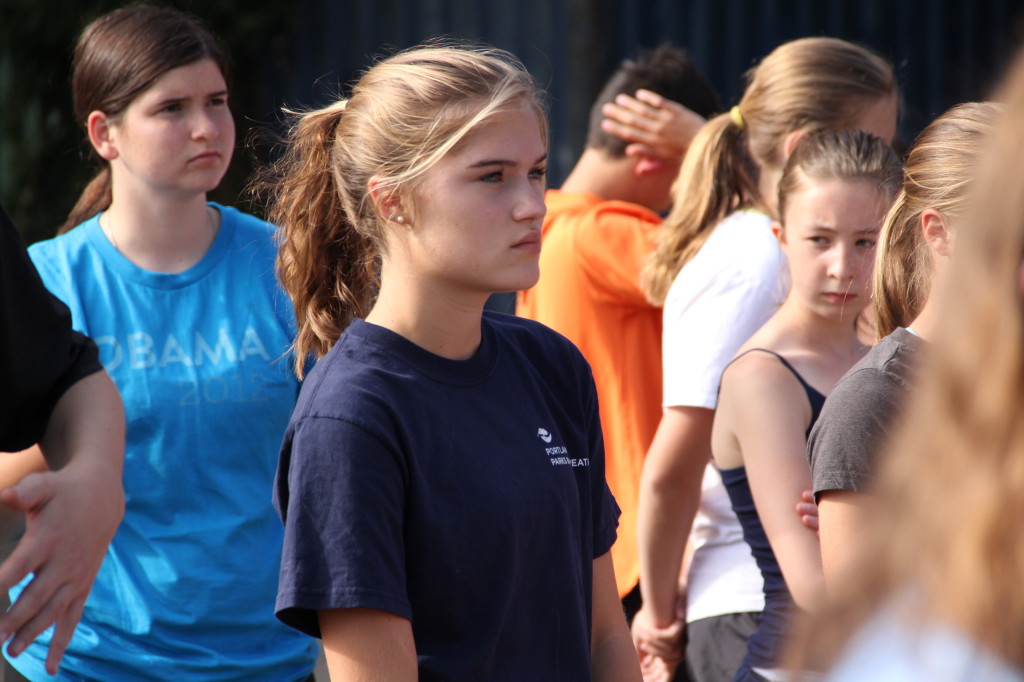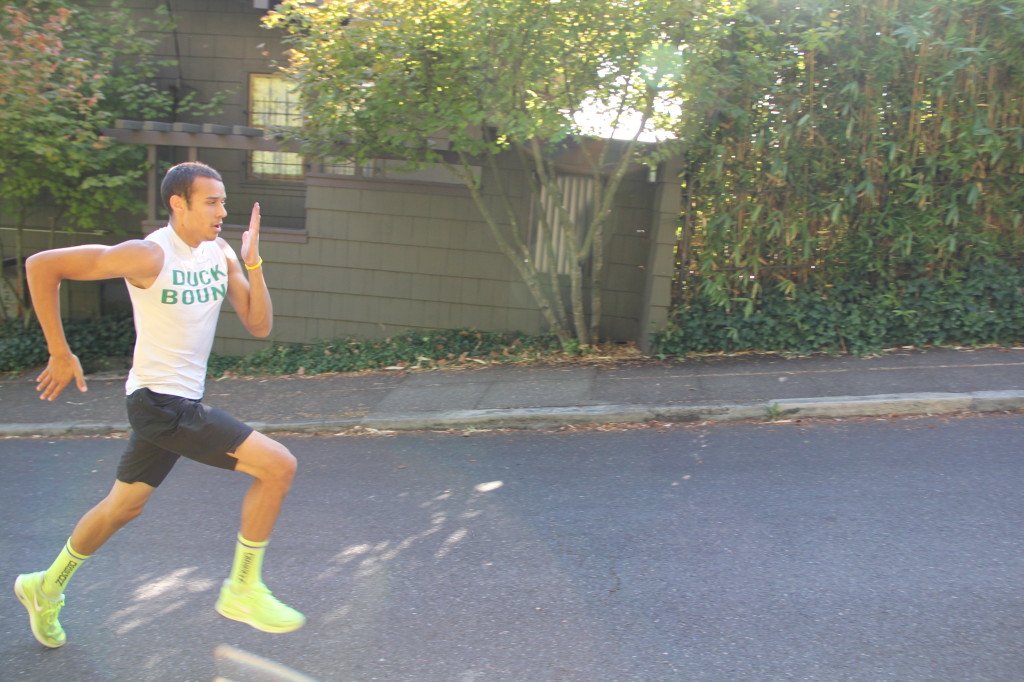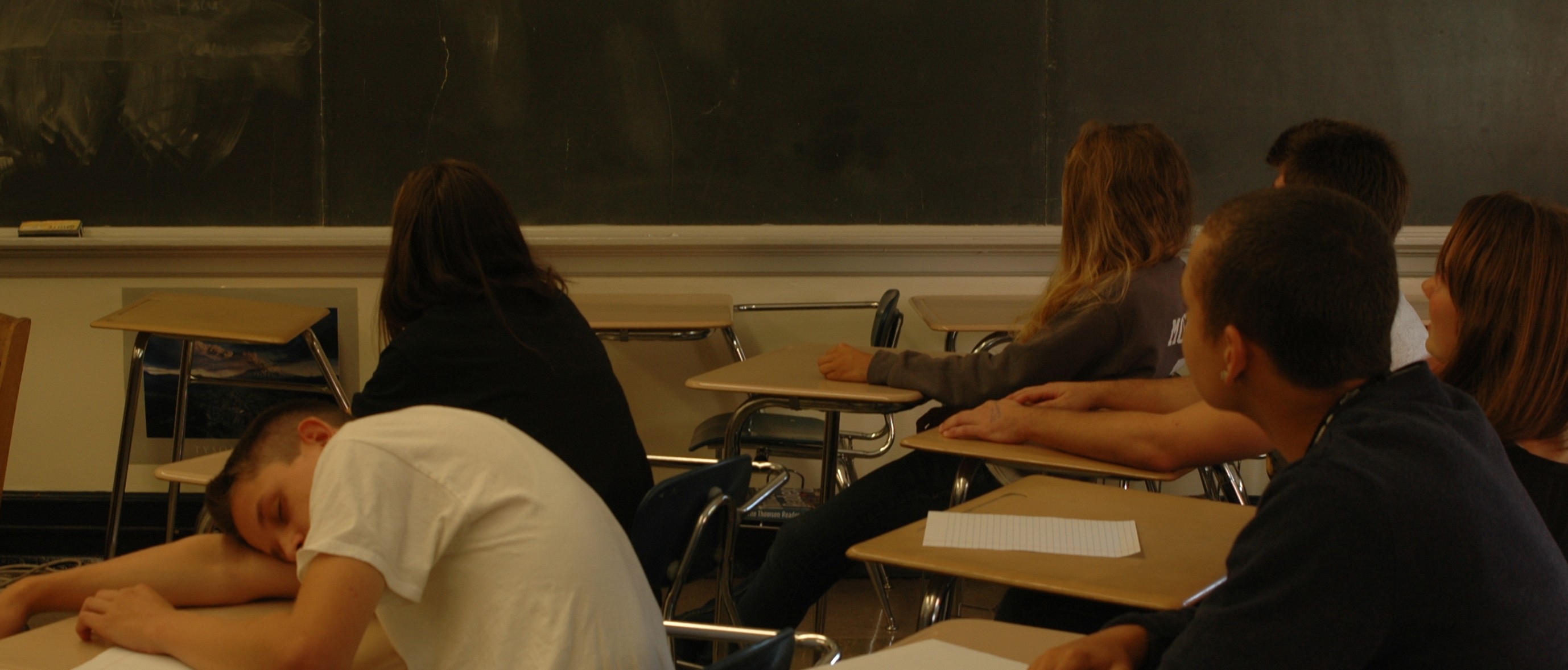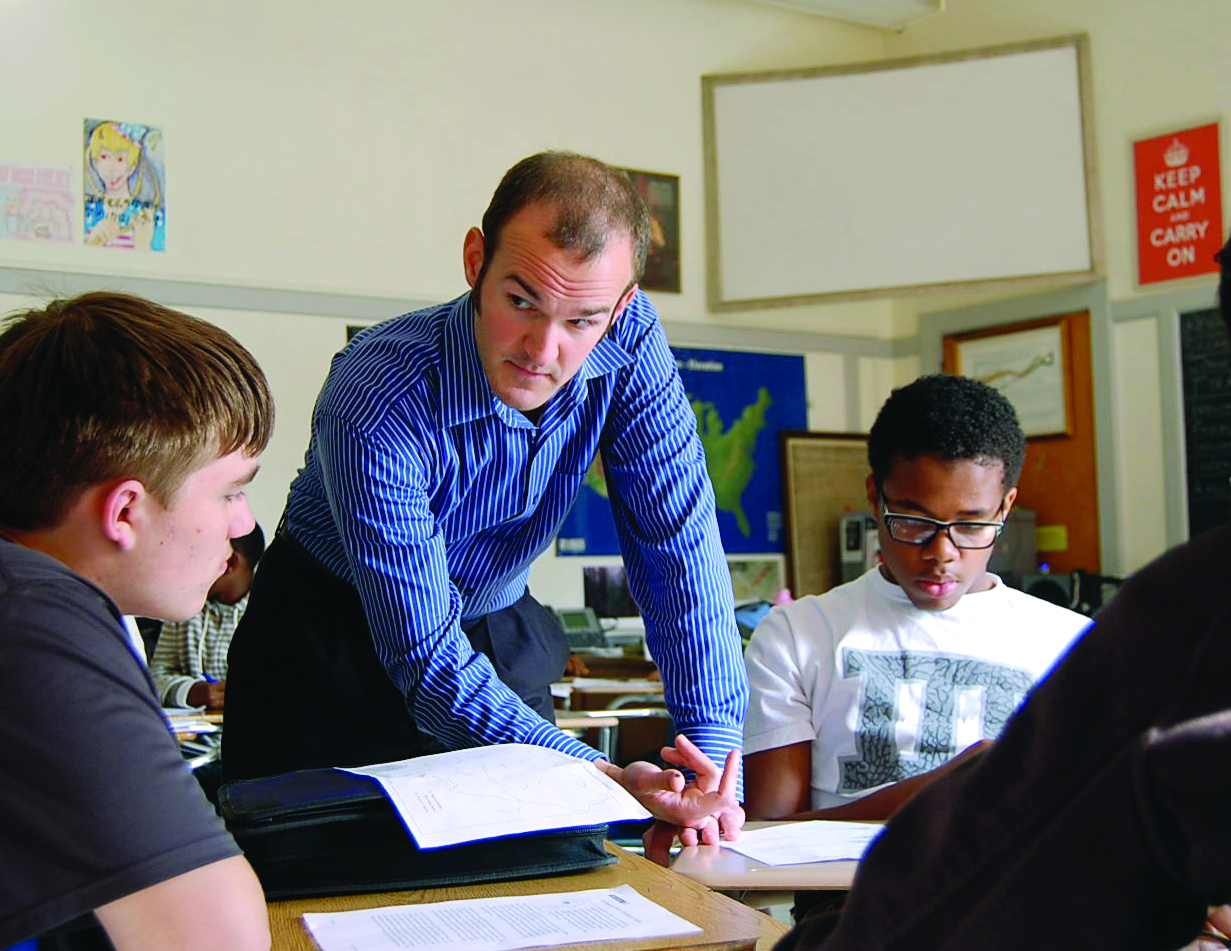
Within Grant High School, passionate athletes aren’t difficult to come by. On game days, the hallways are packed with blue and white jerseys worn by team members who seem to have an endless supply of competitive energy.
But any time you have such a high level of serious athletic involvement, you’re bound to see some injuries. High school athletes, including those at Grant, never expect to come off the fields they’ve grown up playing on with a torn ligament or broken bone.
In reality, injuries like these are common. According to the Centers for Disease Control and Prevention, high school athletes account for an estimated two million injuries, 500,000 doctor visit and 30,000 hospitalizations annually.
Nick Belair, a sophomore at Grant who has been injured and out of sports for nearly a year, has learned the importance of maintaining a positive mentality. With months of rehabilitation still ahead before him before he can return to soccer, basketball, baseball and golf, Belair continues to do what he can to stay in shape.
“It has been pretty devastating,” he says. “But all I can do now is look to the future because the past can no longer help me.”
Helen McDevitt, an orthopedic physical therapist for Rebound, a Portland- and Southwest Washington-based clinic, says the best way for athletes to avoid injury is to dedicate themselves to a vigorous warm up routine. Don’t take them lightly, she says.
And if you’re returning from injury, take it easy until a specialist tells you otherwise. “If they try to come back early from serious injuries, it usually just backfires and they’ll be out for longer,” says McDevitt.
Read about these Grant athletes who are facing different roads back.
Delaney Quentin: back on the sidelines
It’s been almost a year since Delaney Quenton has played in a Grant High School football game.
The senior suffered a double dose of reality when he twisted his right knee in a drill, tearing his anterior cruciate ligament. “I knew it was serious as soon as I felt the pain,” he says now.
After the injury, he underwent reconstructive surgery on his knee. He didn’t want to give up football, so he worked hard in the rehabilitation process to get his strength back. “Sometimes, I got discouraged,” he says.
He spent four months working his way back. But late in a last year, he made a tackle and something went horribly wrong when he hit the turf. “I could feel it slowly tear in my arm,” he recalls. The pain was excruciating.
He tore the labrum in his left shoulder and that injury has kept him out so far this season. Now, he can’t believe his time is almost up.
“I couldn’t believe that it had really happened,” he remembers thinking. “I was in disbelief when the doctor told me the news. I try to support the team and not think about me being hurt, but sometimes I see ways I could help and wish I was out there.”
He had surgery again to repair the shoulder, but the rehabilitation has taken a toll on Quenton mentally. He wants to get back to playing but he isn’t sure whether his body will hold up.
His doctors have cleared him to play but he has doubts. “Yeah, I’ve been cleared but it seems every time I play I get hurt,” Quenton says “And I really don’t want to go through that again.”
Assistant coach Marty Williams described Quenton as resilient. He says despite the injury, the defensive end is there at every game. While he may not be able to play, he still has a presence. “Even though he is not on the field, he is a leader and everyone respects him,” Williams says.
– Oscar Griffin
Piper Donaghu: perserverance on the track
 The more she runs, the more it hurts. Then-freshman Piper Donaghu’s hip is killing her. It’s the State Meet semifinals of the 800-meter run, and there’s no way the Grant High School runner is going to stop.
The more she runs, the more it hurts. Then-freshman Piper Donaghu’s hip is killing her. It’s the State Meet semifinals of the 800-meter run, and there’s no way the Grant High School runner is going to stop.
She crosses the line and qualifies for the final, but the pain is too much. She pulls out of the championship race, frustrated and disappointed by her luck. An unfinished meet and a week of limping through the hallways at Grant follow before she learns the extent of the damage.
A large chunk of bone broke off from the rest of her hip. For the first time in her life, Donaghu went from being constantly active with running, biking and playing soccer to not being able to do a single sit up. “It was strange,” she said, not being able to do anything but limp around as her friends entered their summers ready to go play.
“It was probably the hardest part of her setback, because she didn’t expect it so be so hard to watch,” says Mike Donaghu, Piper’s father and an assistant coach for the track team at Grant.
Healing such a devastating injury takes time. Her only real instruction from doctors and physical therapists was to be patient and rest her body. No physical activity, they said. She missed a large amount of the club soccer season and made the tough decision to give up the sport.
“Yeah, I quit soccer,” she laughs, “But it has nothing to do with my hip. I just kind of had to prioritize.”
It was, in fact, the combination of two sports that led to the extreme nature of her injury. Her broken hip actually began as a stress fracture she obtained from a soccer game that happened when her kick was interrupted. The pain continued to grow as she kept playing soccer and running on it until her 800-meter race.
Donaghu didn’t give up. It’s not in her nature. She’s been a runner her whole life. You could say it comes naturally to her and her two sisters – Ella and Ruby. They certainly have it in their background. Their parents ran at Dartmouth College. Mike Donaghu was a member of Dartmouth’s NCAA Division I runner-up cross country team who ran a sub four minute mile.
Piper Donaghu played soccer and ran as a kid. And she loved both sports. But when she went down with the injury, she impressed her parents with the way she handled it. “With injuries like that,” Mike Donaghu recalls, “people can go in one of two ways: they can either not want to put in the work and just quit, or they can really get after it and work to come back, and that’s definitely what she did.”
She gave up soccer and concentrated on getting back in shape after the injury. “It took a while for me to get back to my normal running self,” she says.
She started doing physical therapy and more conditioning. She was slightly tentative when first starting to run, but as she continued to practice and constantly work on herself, she gained more confidence.
Nearly two years later, Donaghu is running on the cross country team. Her sister, Ella, is currently a freshman who also competes in cross country.
When she looks back on her injury, Piper Donaghu laughs: “I had too much free time without my sports.”
She took third place in the 800 last year at the state meet and participated in the 4×400-meter team relay that set a school record. Now in her junior year, 16 year old Donaghu looks forward to running longer and more vigorous races, such as the 1500-meter run.
As far as college goes, she doesn’t know where she wants to go yet. All Donaghu has on her mind these days is training and running the best she can. In her mind, if the effort is put in and you have a legitimate passwion for what you do, you can come back from almost anything.
– Madeline Metz
Chance Whitehurst: jumping for success
 For Chance Whitehurst, it’s all about the jump.
For Chance Whitehurst, it’s all about the jump.
Setting a mark. Timing. Getting the angle just right. And soaring through the air into the pit.
Whitehurst, a 17-year-old senior, is a triple jump and long jump specialist for the Grant High School boy’s track and field team. Last year as a junior, he placed second in the triple jump at the state meet. But he almost didn’t make it to state because of a serious ankle injury.
During spring break last March, Whitehurst took a trip to San Francisco to visit his brother, Drake, who was a freshman at City College of San Francisco. While his brother was at work, Whitehurst got tired of waiting. He decided to walk down the street to 24-Hour Fitness.
At the gym, Whitehurst joined a pickup basketball game. After a few times down the court, he tried imitating one of his favorite players, Kobe Bryant. He landed on an opposing player’s foot and tore a ligament in his left ankle.
“In the moment, it didn’t really hurt that much,” recalls Whitehurst. “But as I tried to walk it off, I could hardly walk and it just swelled up.”
What made the situation worse was that the track season had just begun, and the injury started a race against time. Would his ankle heal up in time for the state championship in his final year of high school competition?
Growing up, Whitehurst dabbled in just about every sport. He thought he would end up playing football or basketball, but it wasn’t until sophomore year when he found his true passion: track.
On his first day of track practice for Grant, he kept an open mind and was willing to try new events. He ambled over to the triple jump – by all accounts one of the most graceful events – and tried it a few times. To Whitehurst’s surprise, it felt natural for him.
“When you hit a big jump you feel like you’re flying,” Whitehurst says, “I didn’t really get that feeling from anything else.”
After only one year of training, Whitehurst found himself excelling in the event. Last summer, he was invited to train with former Olympian and world champion Carl Lewis and other athletes at the University of Houston and at UCLA. He continues to prepare for the next track season, fitting in time with his personal jump coach and a strength coach.
By the time he started junior year, all the other sports fell off his radar and Whitehurst became focused on jumping. He trained with a passion until the trip to visit his brother. When he returned to Portland after his injury, his doctor put him in a cast and told him to come back in four weeks, but he couldn’t handle being out for that long. “After two weeks, I was done,” Whitehurst says. “I walked in and told them to take it off.”
He went to physical therapy, doing everything he could to regain his strength and balance. His dad, Mitch Whitehurst, recalls coaches having to tell him to slow down. “It’s hard to keep him down,” Mitch Whitehurst says. “He has a lot of energy and he has a lot of focus on what he wants.”
He participated in two track meets before the qualifying district meet, and then came the state meet in Eugene at historic Hayward Field. “I didn’t want to settle for anything less than first,” Whitehurst recalls. “Even though I knew that physically I wasn’t 100 percent, I got that out of my head.”
He was leading the field until a rival from Lincoln High School jumped ahead of him. Whitehurst had one jump left. “When you’re actually there in front of that many people at Tracktown USA, it’s a good feeling,” he recalls. “I was super nervous, but they were good nerves.”
Going down the runway, Whitehurst tried to block everything out: all the thoughts and all the people. He jumped 45 feet, 10 inches, just ¾ of an inch off first place. He was devastated.
“That was the most frustrated I’ve ever seen Chance,” his father says. “He worked so hard to come back from being hurt, and he had it in his hands, but it slipped right through his fingers.”
Whitehurst started planning for this year within a week of the second-place finish. Today, he trains five times a week and sticks to a strict diet plan with minimal sugar. He’s already a Division I college prospect for triple jump and sees himself finishing his senior year at Grant as the triple jump state champion with at least a 50-foot jump.
With a track scholarship offer from University of Houston and a few other schools in mind, Whitehurst says he wants to train in college and participate in the 2016 Olympics.





